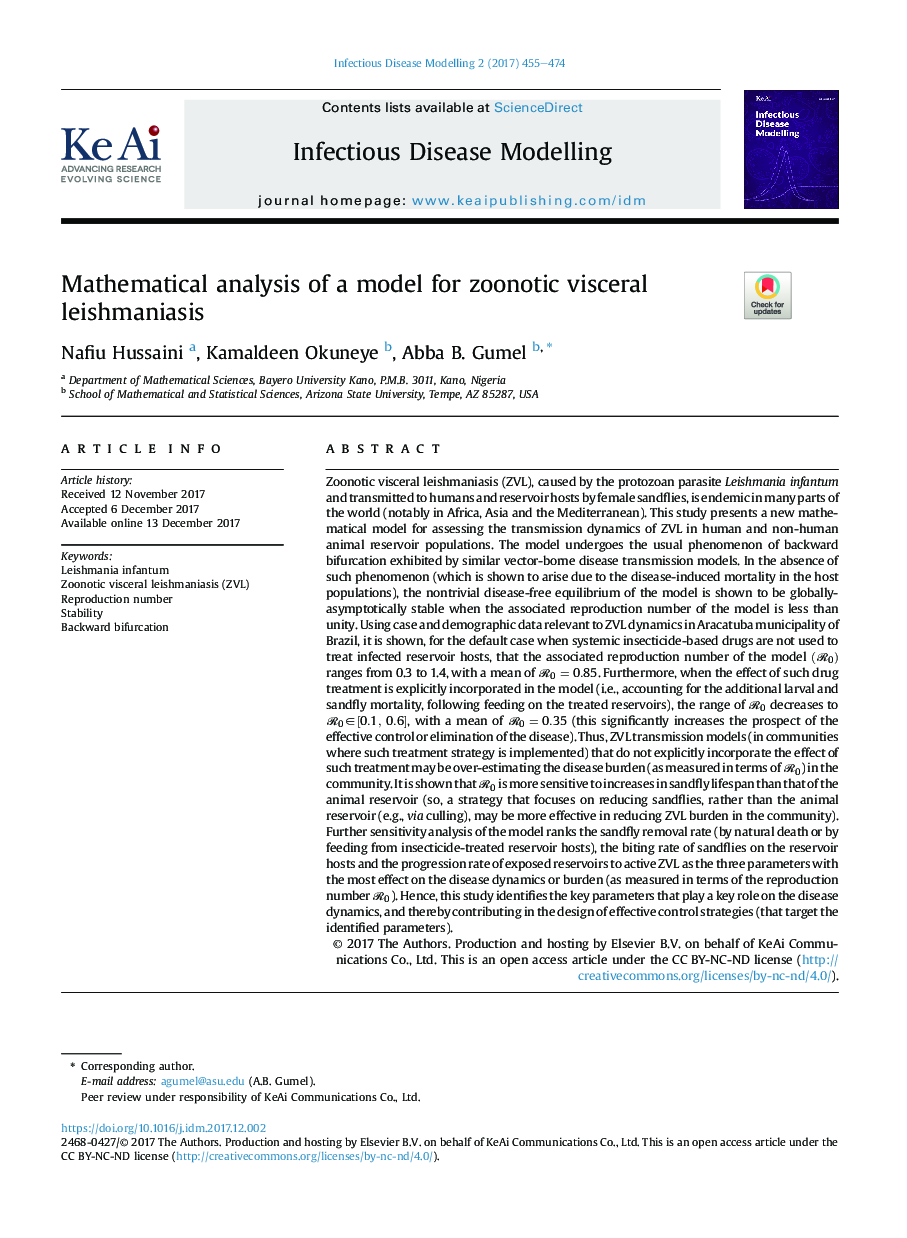| کد مقاله | کد نشریه | سال انتشار | مقاله انگلیسی | نسخه تمام متن |
|---|---|---|---|---|
| 8733286 | 1590567 | 2017 | 20 صفحه PDF | دانلود رایگان |
عنوان انگلیسی مقاله ISI
Mathematical analysis of a model for zoonotic visceral leishmaniasis
ترجمه فارسی عنوان
تجزیه و تحلیل ریاضی یک مدل برای لیشمانیوز احشائی زونیوز
دانلود مقاله + سفارش ترجمه
دانلود مقاله ISI انگلیسی
رایگان برای ایرانیان
کلمات کلیدی
موضوعات مرتبط
علوم پزشکی و سلامت
پزشکی و دندانپزشکی
انفورماتیک سلامت
چکیده انگلیسی
Zoonotic visceral leishmaniasis (ZVL), caused by the protozoan parasite Leishmania infantum and transmitted to humans and reservoir hosts by female sandflies, is endemic in many parts of the world (notably in Africa, Asia and the Mediterranean). This study presents a new mathematical model for assessing the transmission dynamics of ZVL in human and non-human animal reservoir populations. The model undergoes the usual phenomenon of backward bifurcation exhibited by similar vector-borne disease transmission models. In the absence of such phenomenon (which is shown to arise due to the disease-induced mortality in the host populations), the nontrivial disease-free equilibrium of the model is shown to be globally-asymptotically stable when the associated reproduction number of the model is less than unity. Using case and demographic data relevant to ZVL dynamics in AracÌ£atuba municipality of Brazil, it is shown, for the default case when systemic insecticide-based drugs are not used to treat infected reservoir hosts, that the associated reproduction number of the model (â0) ranges from 0.3 to 1.4, with a mean of â0=0.85. Furthermore, when the effect of such drug treatment is explicitly incorporated in the model (i.e., accounting for the additional larval and sandfly mortality, following feeding on the treated reservoirs), the range of â0 decreases to â0â[0.1,0.6], with a mean of â0=0.35 (this significantly increases the prospect of the effective control or elimination of the disease). Thus, ZVL transmission models (in communities where such treatment strategy is implemented) that do not explicitly incorporate the effect of such treatment may be over-estimating the disease burden (as measured in terms of â0) in the community. It is shown that â0 is more sensitive to increases in sandfly lifespan than that of the animal reservoir (so, a strategy that focuses on reducing sandflies, rather than the animal reservoir (e.g., via culling), may be more effective in reducing ZVL burden in the community). Further sensitivity analysis of the model ranks the sandfly removal rate (by natural death or by feeding from insecticide-treated reservoir hosts), the biting rate of sandflies on the reservoir hosts and the progression rate of exposed reservoirs to active ZVL as the three parameters with the most effect on the disease dynamics or burden (as measured in terms of the reproduction number â0). Hence, this study identifies the key parameters that play a key role on the disease dynamics, and thereby contributing in the design of effective control strategies (that target the identified parameters).
ناشر
Database: Elsevier - ScienceDirect (ساینس دایرکت)
Journal: Infectious Disease Modelling - Volume 2, Issue 4, November 2017, Pages 455-474
Journal: Infectious Disease Modelling - Volume 2, Issue 4, November 2017, Pages 455-474
نویسندگان
Nafiu Hussaini, Kamaldeen Okuneye, Abba B. Gumel,
